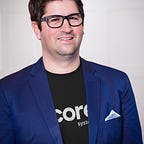Focused on The Crowd: Coresystems AG Wants To Be Uber for Service Technicians
Field service management company Coresystems AG is hoping to remove the pain that comes from waiting for service technicians. Manuel Grenacher, the CEO and founder of the Swiss company, is located in San Francisco and focused on building out the U.S. presence of the business. Its main differentiator? A crowdsourcing model that the company calls “crowd service,” which connects customers in need of help with surrounding qualified technicians in real-time. With the rise of IoT devices that have customers expecting more service and faster, Grenacher says that Coresystems’ ability to provide on-demand service to companies will push them ahead of the competition.
How’s business? Great. We’ve gone from one of the smallest countries into a global presence. We’re at about 160 people now. I founded the company when I was a computer science student in Switzerland. I moved with my family here last year to build our U.S. presence and we’re making progress on bigger customers and got selected by (tech research firm) Gartner last year as one of the best newcomers in our space.
Your family were small business owners. What lessons did you learn from that? We had a furniture company where we did the whole process of furniture making. The first thing you learn is work hard. It’s a really tough business and we worked, more or less, seven days a week. The second thing is respecting your customer base because you see first-hand how important it is for a customer to pay their bill.
As a company operating globally, what are the advantages of working in the Bay Area? Coming to the Bay Area was a personal thing. All my competitors are here. This is a different atmosphere from Zurich, where the big businesses are banks and insurance. So you feel more challenged here, everyday there’s news around the tech companies and this gives you the inspiration to move faster. This atmosphere in the air almost gives a pressure to grow faster. The second thing is that as we continue to grow out of our startup phase, I need people who’ve already scaled a company and I don’t find that in Zurich or Berlin. But obviously as a Swiss-born company, nobody knows us here so we need to build relationships, networks, experience at a pretty intense learning curve.
Where did the idea behind your crowdsourced model come from and what are the benefits of a more distributed technical workforce? The concept behind the crowd model is very similar to Uber or Airbnb. It’s about using the power of crowds and the sharing economy, especially as people are working more in an on-demand world with multiple employers. For field service that’s perfect because nationally or internationally you need people who can act in real time. To do this on your own payroll doesn’t work.
So what are the processes that you are replacing? What we replace are these middle-men people that need to dispatch and make sure the technician is coming and send a note to the customer. That we digitalize.
What are the technologies or trends that have the ability to shift field service management? Crowdsourcing, IoT and augmented reality. These are the three main drivers. You have more people available through crowdsourcing, IoT connects the service to the issue and augmented reality can bring in the know-how to use less skilled people in the field. We use augmented reality at the moment, mainly with the smartphone camera to plug in someone who sees what you see and can guide you in the repair, like a remote support.
How has the rise of IoT technologies changed your industry and the relationship between customer and technician? IoT mainly supports to trigger the service need, but you need to still provide the service. That’s why we believe that an IoT strategy without developing how you deliver the service is wrong. You need to group them together and make the process fully digitized.
It’s easy to put in an IoT sensor to send a signal to the cloud, but it is not so easy to make it so that the technician can act on the signal and coordinate so they can fix the issue. The expectation from the customer is that the issue will be immediately fixed once the signal is sent out. So this is the problem that we solve. We call it closing the loop to IoT with service.
How do you see the company growing and expanding? We really want to become the leader in this specific space, field service. We understand that this is a multi-billion dollar market and we want to make it perfect. The next step is bringing the proof to the U.S. We are already in a leading position in Europe, but not yet in the U.S. We believe we have a great vision and our crowd service model definitely differentiates us. Most of our competitors are just trying to improve the efficiency of their existing employee base, but if you want to scale like Uber did, you have to go beyond that.
Manuel Grenacher
Founder and CEO
U.S. HQ: San Francisco
Company: Coresystems AG
Founded: 2006
Background: The Swiss native started Coresystems A.G. in his home country while completing his studies in computer science. Since then, the company has expanded globally, both in Europe and in Asia before looking to scale up in the United States.
First job: Working at his family’s furniture company
Global employees: 160
Bay Area employees: 25
Global offices:8
Number of service technicians: 190,000 in 82 countries
Education: Computer science degree at the University of Applied Sciences Northwestern Switzerland
Residence: San Francisco
